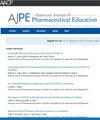将 ChatGPT 作为虚拟导师的概念验证。
IF 3.5
4区 教育学
Q1 EDUCATION, SCIENTIFIC DISCIPLINES
引用次数: 0
摘要
研究目的本研究旨在评估教师为药学管理课程三年级药学博士生开发的基于 ChatGPT 的虚拟辅导的可行性和感知价值。目标是评估教师开发该工具所需的时间,并分析学生的参与度和对其教育价值的认知:虚拟导师由教师开发,包括通过课程学习管理系统部署的定制 ChatGPT 提示。开发指标已记录在案,包括投入的时间和改进提示所需的迭代。使用后问卷调查评估了学生的接受程度和体验,包括使用频率、对学习和备考的感知价值以及总体满意度:结果:虚拟导师的开发共耗时 119 分钟,表明时间投入是可行的。130 名学生中有 92 名完成了问卷调查,回复率为 70%。61名学生(66%)使用了辅导员,使用程度各不相同。大多数学生(82%)表示通过辅导增强了考试信心,99%的学生承认通过辅导增强了对课程材料的理解:虚拟导师被证明是一种可行的教育工具,学生对它的使用率和满意度都很高。它为教育支持提供了一种省时高效的替代方法,有可能减少对传统面对面辅导的需求。这项研究强调了 ChatGPT 作为虚拟导师在药学教育中的有效性和实用性,但进一步的研究应探讨其在不同内容领域的应用以及潜在的意外后果。本文章由计算机程序翻译,如有差异,请以英文原文为准。
Proof of Concept of ChatGPT as a Virtual Tutor
Objective
This study aimed to evaluate the feasibility and perceived value of an instructor-developed ChatGPT-based virtual tutor for third-year Doctor of Pharmacy students in a pharmacy management course. The objectives were to assess faculty time required to develop the tool and analyze student engagement and perception of its educational value.
Methods
The virtual tutor was developed by the instructor and consisted of custom ChatGPT prompts deployed via the course’s learning management system. Development metrics were documented, including time invested and iterations needed for prompt refinement. A after-use questionnaire evaluated student uptake and experience, which included frequency of use, perceived value for learning and exam preparation, and overall satisfaction.
Results
The development of the virtual tutor required a total of 119 min, demonstrating a feasible time investment. Ninety-two of 130 students completed the questionnaire for a 70% response rate. Sixty-one students (66%) engaged with the tutor, with varying degrees of use. Most students (82%) reported increased confidence for exams, and 99% acknowledged enhanced understanding of the course material through the tutor.
Conclusion
The virtual tutor proved to be a feasible educational tool, with considerable student uptake and satisfaction. It offered a time-efficient alternative for educational support, potentially reducing the need for traditional face-to-face tutoring. The study highlights the effectiveness and practicality of ChatGPT as a virtual tutor in pharmacy education, but further research should explore its application across different content areas as well as potential unintended consequences.
求助全文
通过发布文献求助,成功后即可免费获取论文全文。
去求助
来源期刊
CiteScore
4.30
自引率
15.20%
发文量
114
期刊介绍:
The Journal accepts unsolicited manuscripts that have not been published and are not under consideration for publication elsewhere. The Journal only considers material related to pharmaceutical education for publication. Authors must prepare manuscripts to conform to the Journal style (Author Instructions). All manuscripts are subject to peer review and approval by the editor prior to acceptance for publication. Reviewers are assigned by the editor with the advice of the editorial board as needed. Manuscripts are submitted and processed online (Submit a Manuscript) using Editorial Manager, an online manuscript tracking system that facilitates communication between the editorial office, editor, associate editors, reviewers, and authors.
After a manuscript is accepted, it is scheduled for publication in an upcoming issue of the Journal. All manuscripts are formatted and copyedited, and returned to the author for review and approval of the changes. Approximately 2 weeks prior to publication, the author receives an electronic proof of the article for final review and approval. Authors are not assessed page charges for publication.

 求助内容:
求助内容: 应助结果提醒方式:
应助结果提醒方式:


